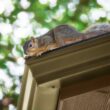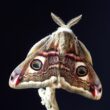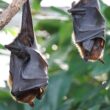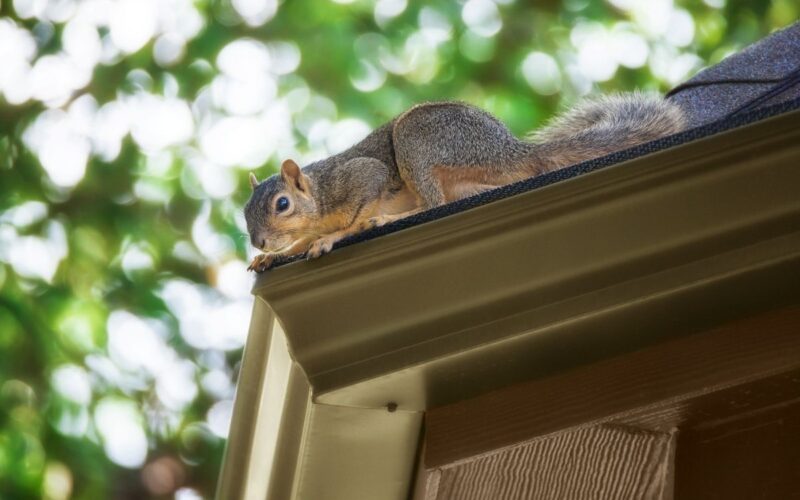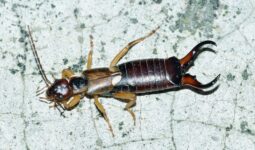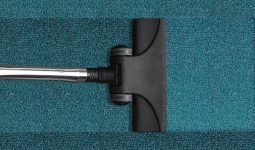Squirrels scrambling around your soffits at dawn isn’t just annoying—it’s a warning sign of potential structural damage that could cost thousands to repair.
These agile rodents can chew through soffit materials, contaminate your attic space, and create entry points for other pests in surprisingly short periods.
You’ll discover multiple proven removal techniques that work without harming the animals, plus comprehensive prevention strategies that protect your investment long-term.
Whether you’re dealing with an active invasion or want to prevent future problems, this guide covers everything from identifying early warning signs to implementing professional-grade deterrent systems.
Signs of Squirrels in Soffits
Recognizing squirrel activity early prevents extensive damage and reduces removal complexity. Most homeowners miss subtle initial signs until the problem becomes severe.
Key Insight: Squirrels are most active during dawn and dusk hours, making these optimal times for detection.
Visual indicators reveal themselves through damaged soffit materials, including chewed holes typically 1.5 to 3 inches in diameter, scratched or gouged wood surfaces around potential entry points, and torn or displaced soffit screens. Fresh wood shavings or debris beneath soffits indicate recent chewing activity, while squirrel droppings near entry points confirm active occupation.
Auditory evidence becomes apparent through scratching sounds in walls or ceilings, particularly during early morning or evening hours, scurrying noises that differ from typical settling sounds, and chattering or squeaking vocalizations from adult squirrels communicating with offspring.
Behavioral patterns include observing squirrels entering or exiting specific soffit areas, increased squirrel activity around your roofline compared to neighboring properties, and territorial marking behaviors such as aggressive posturing toward other wildlife near their nesting sites.
Secondary damage indicators often appear as disturbed insulation visible through soffit gaps, damaged electrical wiring or ductwork accessible through breached soffits, and water stains on interior walls where squirrel entry has compromised weather sealing.
Why Squirrels Are a Problem in Soffits
Soffits provide ideal nesting conditions that attract squirrels seeking shelter, but their occupancy creates serious problems for homeowners.
Structural vulnerabilities make soffits particularly appealing to squirrels. These areas offer protected spaces between roof overhangs and exterior walls, creating wind-resistant shelter with easy access to attic spaces.
Building materials commonly used in soffits, including aluminum, vinyl, and wood, provide varying levels of resistance to determined squirrels equipped with powerful teeth designed for gnawing through tough materials.
Common Mistake: Assuming aluminum soffits are squirrel-proof—determined squirrels can chew through thin aluminum materials, especially around edges and fastener points.
Property damage escalation occurs through multiple pathways:
- Immediate structural damage includes enlarged entry holes that compromise weather resistance, damaged soffit panels requiring complete replacement, and torn soffit venting that reduces attic airflow efficiency
- Long-term deterioration encompasses water infiltration through unsealed openings leading to rot and mold issues, compromised insulation effectiveness reducing energy efficiency, and pest pathway creation that invites additional unwanted wildlife
Health and safety concerns stem from squirrel occupation patterns. Disease transmission risks include bacterial contamination from droppings and urine, parasitic infections from fleas and ticks carried by squirrels, and respiratory irritation from accumulated waste products in confined spaces. Fire hazards increase when squirrels chew electrical wiring, while structural instability develops as repeated entry and nesting activities weaken soffit attachment points.
Financial implications compound over time through emergency repair costs that exceed planned maintenance expenses, increased energy bills due to compromised building envelope integrity, and potential insurance claim complications when wildlife damage extends beyond standard coverage parameters.
How to Get Rid of Squirrels From Soffits
Effective squirrel removal requires strategic approaches that prioritize both animal welfare and permanent solutions. Professional wildlife removal specialists emphasize that there is no good squirrel repellent that will get rid of them, making hands-on removal techniques essential.
Immediate Safety Assessment
Before attempting any removal method, evaluate the situation thoroughly. Check for baby squirrels during spring and early summer months (March through August), as removing adults while offspring remain creates both ethical concerns and incomplete solutions. Adult squirrels with young typically exhibit increased territorial behavior and may cause additional damage when separated from their nest.
Humane Live Trapping Method
Live trapping represents the most reliable removal approach for established squirrel populations. Live trapping, while labor intensive, is the only reliable method for removing squirrels once they are in the attic, and this principle applies equally to soffit invasions.
Pro Tip: Use peanut butter as bait rather than nuts, as its sticky consistency prevents squirrels from stealing the bait without triggering the trap mechanism.
Professional trapping setup requires strategic trap placement near identified entry points, preferably during early morning or evening hours when squirrels are most active. Wildlife control professionals use humane trapping methods to safely remove the squirrels by positioning traps along established travel routes rather than directly at nest sites.
DIY trapping considerations include selecting appropriately sized traps (minimum 24 inches long for gray squirrels), checking traps every 4-6 hours to minimize animal stress, and ensuring trap placement doesn’t expose captured animals to extreme temperatures or predators.
One-Way Exclusion Doors
One-way exclusion devices allow squirrels to exit soffits naturally without permitting re-entry. This method works effectively when you’re certain no young squirrels remain inside.
Installation involves identifying all entry points through thorough soffit inspection, sealing all openings except one primary exit route, and mounting the exclusion door over the remaining opening. Monitor the device for 3-5 days to confirm all squirrels have departed before sealing the final exit point.
Natural Deterrent Integration
Predator urine is a highly effective natural deterrent for squirrels, mimicking the presence of threats like foxes or badgers and reducing their comfort level in soffit areas. Apply commercially available fox or coyote urine around soffit perimeters, focusing on areas where squirrels typically approach from nearby trees.
Important Note: Reapply natural deterrents after rainfall or every 7-10 days for maintained effectiveness.
Sound-based deterrents using ultrasonic devices or motion-activated noise makers provide supplementary pressure but rarely work as standalone solutions. Combine these with other methods for enhanced effectiveness.
Professional Removal Services
Many firms offer comprehensive services including sealing gaps to prevent future access, humane live-trapping for safe removal, and ongoing monitoring plans that ensure long-term success. Professional services become necessary when DIY methods fail repeatedly, multiple animals are involved, or structural damage requires specialized repair skills.
Service evaluation criteria should include licensing verification for wildlife control operations, humane handling certifications, warranty policies for exclusion work, and comprehensive damage assessment capabilities that address both immediate removal and long-term prevention.
Preventing Squirrels From Returning
Long-term squirrel prevention requires addressing both physical access points and environmental attractants that draw them to your property.
Physical Exclusion Systems
Hardware cloth installation provides the most effective physical barrier against future invasions. Use hardware cloth to seal off gable vents and other potential entry points, ensuring mesh spacing doesn’t exceed ¼-inch to prevent juvenile squirrels from squeezing through.
| Exclusion Material | Effectiveness | Durability | Best Use |
|---|---|---|---|
| Hardware Cloth (¼-inch) | Excellent | 10+ years | Large openings, vents |
| Copper Mesh | Very Good | 5-7 years | Small gaps, irregular spaces |
| Steel Wool | Good | 1-2 years | Temporary fixes, cracks |
| Expanding Foam | Poor | 6 months | Interior gaps only |
Soffit gap sealing addresses the most common entry points through systematic inspection and repair. Use copper mesh wool or Xcluder Fill Fabric to stuff into holes and bigger openings, and for smaller openings, use foams in an aerosol form such as expanding foam specifically designed for pest exclusion.
Tree Management Strategies
Branch trimming protocols eliminate squirrel highways that provide easy roof access. Maintain minimum 8-foot distances between tree branches and your roofline, as squirrels can jump approximately 8-10 feet horizontally. Focus on overhanging branches from oak, maple, and pine trees that squirrels prefer for travel routes.
Vertical barriers installed on tree trunks prevent squirrels from climbing to roof level. Metal baffles positioned 6-8 feet above ground level create effective climbing obstacles when properly installed with smooth surfaces that can’t be gripped by squirrel claws.
Environmental Modifications
Food source elimination reduces property attractiveness by removing or securing bird feeders during peak squirrel activity seasons, cleaning up fallen nuts and fruits promptly, and using squirrel-resistant bird feeder designs when maintaining bird feeding stations.
Habitat modification involves reducing nesting opportunities through regular debris removal from gutters and roof areas, maintaining clean and uncluttered soffit zones, and eliminating brush piles or wood stacks near the house that provide intermediate shelter.
Common Mistake: Installing bird feeders within 50 feet of your home effectively attracts squirrels to the area, making soffit invasion more likely regardless of other prevention measures.
Ongoing Maintenance Requirements
Seasonal inspection schedules should include spring assessments after winter weather damage, fall preparations before prime nesting season, and post-storm evaluations when high winds may compromise exclusion materials.
Key Insight: Most squirrel re-invasions occur through previously repaired areas where exclusion materials have degraded or shifted over time.
Maintenance task priorities involve checking hardware cloth attachments for loosening or rust damage, verifying foam sealants haven’t cracked or shrunk, and ensuring tree trimming maintains adequate clearance distances as branches grow.
When to Call a Professional
Certain squirrel situations require professional wildlife control expertise to ensure safe, effective, and legally compliant resolution.
Complexity Indicators
Multiple entry points suggest established colonies that require comprehensive exclusion strategies beyond typical DIY capabilities. When squirrels have created 3 or more access points, they’ve likely developed complex travel patterns and backup routes that make simple sealing attempts ineffective.
Structural damage assessment becomes critical when squirrels have compromised load-bearing elements, created large openings that affect weather sealing, or damaged electrical systems accessible through soffit areas. Professional evaluation determines repair priorities and safety considerations that homeowners typically can’t assess accurately.
Breeding season complications occur when adult squirrels with dependent offspring require specialized handling. Relocating squirrels is inhumane, making professional knowledge of local wildlife regulations and humane handling protocols essential during spring and summer removal attempts.
Professional Service Benefits
Comprehensive damage repair addresses both immediate squirrel removal and long-term structural restoration that prevents future invasions. Professional services typically include materials and labor warranties that guarantee exclusion effectiveness for specified periods.
Legal compliance assurance becomes particularly important in areas with strict wildlife protection regulations. Licensed professionals understand local ordinances regarding animal relocation, disposal, and handling requirements that protect homeowners from potential legal issues.
Equipment and expertise advantages include specialized trapping equipment designed for specific squirrel species, professional-grade exclusion materials with longer lifespans than retail products, and experience recognizing subtle signs of re-infestation that homeowners commonly miss.
Cost-Benefit Analysis
DIY expense accumulation through repeated material purchases, trial-and-error approaches, and potential property damage from ineffective exclusion attempts often exceeds initial professional service costs.
Time investment considerations factor in the learning curve required for effective squirrel control, ongoing monitoring requirements, and potential work disruptions when DIY methods require multiple attempts over extended periods.
Long-term success rates favor professional services for complex situations, with industry data showing 90%+ success rates for licensed wildlife control specialists compared to 60-70% success rates for homeowner DIY attempts involving multiple animals or extensive property damage.
Service Selection Criteria
Licensing verification should include state wildlife control permits, business licensing for pest control services, and insurance coverage for property damage and animal handling liability.
Method evaluation involves confirming humane handling practices, exclusion technique explanations, and warranty terms for both removal services and prevention measures installed during professional service.
Pro Tip: Request detailed written estimates that itemize removal, exclusion, and repair services separately, allowing you to evaluate each component’s necessity and cost-effectiveness for your specific situation.
